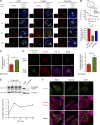The exocyst controls lysosome secretion and antigen extraction at the immune synapse of B cells
- PMID: 31197029
- PMCID: PMC6605794
- DOI: 10.1083/jcb.201811131
The exocyst controls lysosome secretion and antigen extraction at the immune synapse of B cells
Abstract
B lymphocytes capture antigens from the surface of presenting cells by forming an immune synapse. Local secretion of lysosomes, which are guided to the synaptic membrane by centrosome repositioning, can facilitate the extraction of immobilized antigens. However, the molecular basis underlying their delivery to precise domains of the plasma membrane remains elusive. Here we show that microtubule stabilization, triggered by engagement of the B cell receptor, acts as a cue to release centrosome-associated Exo70, which is redistributed to the immune synapse. This process is coupled to the recruitment and activation of GEF-H1, which is required for assembly of the exocyst complex, used to promote tethering and fusion of lysosomes at the immune synapse. B cells silenced for GEF-H1 or Exo70 display defective lysosome secretion, which results in impaired antigen extraction and presentation. Thus, centrosome repositioning coupled to changes in microtubule stability orchestrates the spatial-temporal distribution of the exocyst complex to promote polarized lysosome secretion at the immune synapse.
© 2019 Sáez et al.
Figures








Similar articles
-
Proteasome Dependent Actin Remodeling Facilitates Antigen Extraction at the Immune Synapse of B Cells.Front Immunol. 2019 Feb 19;10:225. doi: 10.3389/fimmu.2019.00225. eCollection 2019. Front Immunol. 2019. PMID: 30873155 Free PMC article.
-
Polarized secretion of lysosomes at the B cell synapse couples antigen extraction to processing and presentation.Immunity. 2011 Sep 23;35(3):361-74. doi: 10.1016/j.immuni.2011.07.008. Epub 2011 Aug 4. Immunity. 2011. PMID: 21820334
-
Polarity protein Par3 controls B-cell receptor dynamics and antigen extraction at the immune synapse.Mol Biol Cell. 2015 Apr 1;26(7):1273-85. doi: 10.1091/mbc.E14-09-1373. Epub 2015 Jan 28. Mol Biol Cell. 2015. PMID: 25631815 Free PMC article.
-
How B cells capture, process and present antigens: a crucial role for cell polarity.Nat Rev Immunol. 2013 Jul;13(7):475-86. doi: 10.1038/nri3469. Nat Rev Immunol. 2013. PMID: 23797063 Review.
-
Tuning B cell responses to antigens by cell polarity and membrane trafficking.Mol Immunol. 2018 Sep;101:140-145. doi: 10.1016/j.molimm.2018.06.013. Epub 2018 Jun 20. Mol Immunol. 2018. PMID: 29935436 Review.
Cited by
-
Actin reorganization at the centrosomal area and the immune synapse regulates polarized secretory traffic of multivesicular bodies in T lymphocytes.J Extracell Vesicles. 2020 Jun 19;9(1):1759926. doi: 10.1080/20013078.2020.1759926. J Extracell Vesicles. 2020. PMID: 32939232 Free PMC article.
-
Dynamic Microtubule Arrays in Leukocytes and Their Role in Cell Migration and Immune Synapse Formation.Front Cell Dev Biol. 2021 Feb 9;9:635511. doi: 10.3389/fcell.2021.635511. eCollection 2021. Front Cell Dev Biol. 2021. PMID: 33634136 Free PMC article. Review.
-
GEF-H1 Transduces FcεRI Signaling in Mast Cells to Activate RhoA and Focal Adhesion Formation during Exocytosis.Cells. 2023 Feb 7;12(4):537. doi: 10.3390/cells12040537. Cells. 2023. PMID: 36831204 Free PMC article.
-
Immunological synapse: structures, molecular mechanisms and therapeutic implications in disease.Signal Transduct Target Ther. 2025 Aug 11;10(1):254. doi: 10.1038/s41392-025-02332-6. Signal Transduct Target Ther. 2025. PMID: 40784895 Free PMC article. Review.
-
B cell mechanosensing regulates ER remodeling at the immune synapse.Front Immunol. 2024 Oct 7;15:1464000. doi: 10.3389/fimmu.2024.1464000. eCollection 2024. Front Immunol. 2024. PMID: 39434873 Free PMC article.
References
Publication types
MeSH terms
Substances
Grants and funding
LinkOut - more resources
Full Text Sources
Molecular Biology Databases

